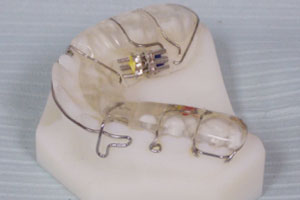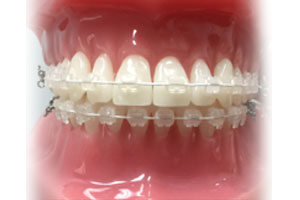We all know the harmful effects of sugar on teeth, the bacteria metabolize the carbohydrates releasing acid by- products, and in a short period of time, combined with poor oral hygiene, holes develop in the enamel. Spoiled by numerous campaigns, the Australian public and other developed countries have been educated over the last 4 to 5 decades, dental decay is now largely under control(1), but by no means eliminated. Dentists are still being kept busy managing dental decay in their practices and will not be out of a job for a while yet.
However, a more insidious and less known consequences of sugar is its effects on facial growth and airway.
Carbohydrates are essentially made up of multiple chains of sugar molecules. Once ingested, all carbohydrates are broken down into these simple sugar molecules. Carbohydrates are mostly found in processed foods and they are not necessarily sweet, such as bread, potatoes, pastas. Some foods such as tomato sauce is laden with sugar, but the ‘sweetness’ is masked by salt. Many people still believe only ‘sweets’ cause dental decay. The bottom line is that, whenever carbohydrates are consumed, sugar is pumped in-to the body.

Before we discuss the other effects of carbohydrates and therefore sugar, let me share with you the studies done by Weston Price.
Dr Price was a dentist from Cleveland, USA, in the 1930s, he observed at his own practice that increasing number of his patients were suffering from chronic diseases and the younger children in particular had high incidence of deformed arches, crowded teeth and dental decay. He pondered why this was happening, as he did not see cases like these 15 years ago.
He has also heard reports that native people who lived in isolated areas did not have any of these chronic conditions. He then travelled to some of these isolated villages to satisfy his own curiosity, why are these people so healthy? And why are so many people back home so unhealthy?
Dr Price visited isolated places in the Swiss Alps, cold and blustery islands off the coast of Scotland, to the Andes mountains in Peru. In total he visited 14 groups of native people.
He also found that less than 1% of the population had dental decay and the majority had well formed dental arches and facial features. These native people ate what mother nature has provided for them, they ate food from the ocean and from the ground, absolutely zero refined sugar and only whole-grain and other unrefined foods.
Fast forward to today, I am seeing not too dissimilar cases at my own practices from those Dr Price observed in the 1930s. I dare say I am seeing more than he did then.
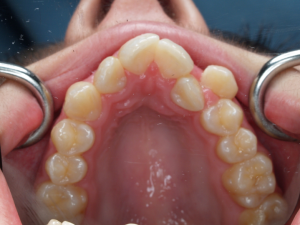
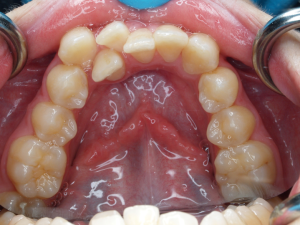
Here is a typical consultation at my office for young children. A 10 year old sits in the dental chair. Mum is concerned about the child’s crooked teeth, if and when he/she needs to wear braces.
With these patients, almost without exceptions, I see a small and narrow jaws, crowded teeth, and there is always a certain degree of mouth breathing. Note that some parents may not be aware that their child has been mouth breathing (nor themselves). A healthy person breathes through the nose 100% at rest, the lips are closed together and should only be apart when eating, talking or while taking breathes after an episode of heavy exercises.
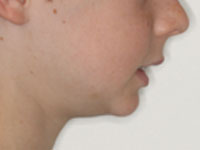 The picture above shows a chronic mouth breather, typically, the chin tends to be positioned too far back.
The picture above shows a chronic mouth breather, typically, the chin tends to be positioned too far back.
The mouth breathing varies from a subtle opening between the upper and lower lips to an opened mouth large enough for a Coke can to pass through. At rest, the nose is designed for breathing, its tiny hairs inside tend to filter microbes, furthermore, it warms and humidifies the air. Chronic mouth breathing tends to bypass the natural protection and consequently the body’s immune system has to work harder.
 In many cases, I am also seeing the glazed eyes, dark circles under the eyes and the creased tip of the nose as illustrated in the photo above. The picture shows the typical ‘allergic salute’, due to chronic irritation of mucus build up in the nasal passages, the child repeatedly rubs the nose accompanied by the sniffing.
In many cases, I am also seeing the glazed eyes, dark circles under the eyes and the creased tip of the nose as illustrated in the photo above. The picture shows the typical ‘allergic salute’, due to chronic irritation of mucus build up in the nasal passages, the child repeatedly rubs the nose accompanied by the sniffing.
The tonsils and adenoids, as parts of the immune system become enlarged and therefore constricting the airway further.
 Left untreated, the airway progressively narrows, reducing the amount of air passing through the nasal passages, compromising the growth of the upper jaw and midface (nasal bones, cheek bones and other bones supporting the face), it’s the ‘use it or lose it’ principle at work.
Left untreated, the airway progressively narrows, reducing the amount of air passing through the nasal passages, compromising the growth of the upper jaw and midface (nasal bones, cheek bones and other bones supporting the face), it’s the ‘use it or lose it’ principle at work.
Mouth breathing also causes the tongue to drop down, unfavourably modifying the ideal horizontal growth to a less favourable vertical growth of the face, affecting the balance and beauty of the child’s face. As discussed in ‘The hidden dangers behind snoring’, the effects of mouth breathing are still being felt much later on in life. In essence, as shown by the native villagers in the Dr Price study, the oral muscles such as the lips and cheeks on the outside and the tongue in the inside, are our very own orthodontic appliances, IF they function properly.
For Proper Jaw And Facial Development The Child Must Develop These Most Important Habits:
- Breathe through the nose
- Lips closed together
- Proper swallowing
What’s happening?
In 2014 Grimshaw(2) and associates collected food diaries from the parents of 1,140 babies to see if different types of foods have any influence on food allergies,
They found that babies without food allergies had a diet that was rich in healthy, often homemade, foods – including fruits, vegetables, poultry and fish, and low on processed foods such as pre-made meals, potato chips, sauces and bacon.
“The analysis showed that the infants who were having more fruits and vegetables and less commercially produced baby foods and also less adult foods were the ones who were less likely to develop an allergy by the time they were two,” Grimshaw said.
A landmark study in 1973(3) by The American Society for Clinical Nutrition showed the effects of sugar on the immune system. When 100 grams of sugar is ingested, (amount equivalent to 1 litre bottle of a soft drink), the white blood cells are 40 percent less effective at killing germs for at least 5 hours after sugar consumption! Conversely, they found that fasting for 36 hours significantly boosted the immune system, when the sugar levels are at their lowest.
The results of these studies are consistent with Dr Price’s findings, processed foods tend to cause havoc on the immune system. Allergies cause mucus build up in the nasal cavities, hindering nasal breathing. The soft tissues lining the airway have the tendency to swell up, constricting the airway further, which leads to mouth breathing. The more severe the airway obstruction, the wider the mouth opens.
A recent study(4) also shows some babies are born with heightened response to certain types of foods such as peanuts and even pizza. The authors could only speculate the reasons behind this allergic predisposition, but they did consider the possibility of environmental causation.
It is therefore feasible to conclude that consuming diet high in processed foods, contribute to increasing incidence of allergies in the developed countries. Allergies are most complex human conditions, there are still a lot of unanswered questions, however, I believe its combination with stress and environmental (chemical) toxins plays a major part.
How do you suspect if your child has compromised airway?
- Mouth Breathing – Lips apart. Observe if the lips are apart while at rest, or while asleep. The further the lips are apart, the narrower is the upper jaw.
- Chapped Lips – dry lips
- Dry mouth
- Gingivitis- bleeding gums
- Orthodontic issues – Crooked teeth, cross bite, overbite, ‘bucked’ teeth.
- Loud grinding of teeth during sleep
- Dark circles under the eyes
- Change in Head Posture – Posturing the head forward and/or tipping the forehead backwards
- Enlarged Tonsil and Adenoid – Chronic sinus problems, throat problems
- Snoring – Children do not usually snore
- Chronic allergies, nasal passages are continuously blocked.
- Bed wetting
- Reflux in the Eustachian Tube – Leads to inner ear infections
Management
Now we see the signs of allergies and their effects, what can we do?
The objective is to create the ideal environment for the child to grow optimally. When the environment is right, nature will do its magic in developing the human body; things start to go wrong when we eat processed foods from birth. The good news is that it’s never too late to treat problems later in life, once the problems are recognised and identified, we can facilitate nature to carry on with its work.
At The Dentist
Medical History
Asthma, allergies to foods and medications, medications taken, sleep pattern, snoring, bedwetting, headaches.
Examinations
Check facial features – retruded lower jaw (weak chin), black rings under eyes, flat or concave mid and lower face, facial asymmetries, enlarged ade-noids, crowded teeth.
Records
- Photographs – to check profile
- Impressions – study models
- Xrays – to check dental development
- 3D scans – to check airway
Referrals to Specialists
- ENT (Ear Nose and Throat) surgeons
- Allergists
- Myologists
- Nutritionists
- Physiotherapists
Extraoral Aids
Sleep Angels and Breath Right strips are two of several extraoral aids that can be helpful in facilitating nasal breathing while asleep.
Sleep Angels
| Breathe Right Strips
|
Orthodontic Treatment
Myotrainer – to train the oral muscles to function optimally and to facilitate nasal breathing |
|
Functional appliances Functional appliances are designed to expand the jaws both anterio-posteriorly (forward) and laterally (side ways). Expanded jaws allow more space for the tongue and improve the bite. |
Braces Braces can either be done in conjunction with the functional appliances or after, depending on the age of the patient. |
Summary
Everyone knows sugar causes dental decay, but its effects on the development of the face, jaws and teeth are much less known. Anthropological findings by Dr Weston Price and recent studies indicate that sugar and processed foods may play a big part in the increasing incidence of allergies in the modern society, which in turn cause many dental problems that dentists are seeing today at their office.
This information is most useful for parents, it motivates them to give their children healthy whole foods, to recognize early signs of problems and to be aware of the relevant treatments available so that the conditions can be managed accordingly at any age. Early management can prevent more difficult or unnecessary treatments later in life such extractions and jaw surgery.
This article may be used with permission by Dr. John Utama,
(1) Produced by the AIHW and the Dental Statistics and Research Unit, Australian Research Centre for Population Oral Health, University of Adelaide.
(2) Diet and food allergy development during infancy: Birth cohort study findings using prospective food diary data
February 2014Volume 133, Issue 2, Pages 511–519
Kate E.C. Grimshaw, PhD, RD Joe Maskell, MSc Erin M. Oliver, MSc Ruth C.G. Morris, Dip HE, RN(Child) Keith D. Foote, MBBS, FRCPCH
E.N. Clare Mills, PhD Barrie M. Margetts, PhD, FFPH Graham Roberts, DM, MRCPCH
(3) Am J Clin Nutr 1973 26: 11 1180-1184 http://ajcn.nutrition.org/content/26/11/1180.full.pdf+html
Role of sugars in human neutrophilic phagocytosis Albert Sanchez, J. L. Reeser, H. S. Lau, P. Y. Yahiku, R. E. Willard, P. J. McMillan, SY. Cho, A. R. Magie, and U. D. Register
(4) Cord blood monocyte–derived inflammatory cytokines suppress IL-2 and induce nonclassic “TH2-type” immunity associated with development of food allergy Yuxia Zhang1,2,3,*, Fiona Collier4,5, Gaetano Naselli1, Richard Saffery2,6, Mimi LK. Tang2,6, KatrinJ. Allen2,6, Anne-Louise Ponsonby2,6, Leonard C. Harrison1,2,*,†, Peter Vuillermin2,4,5,6,*,†, on behalf of the BIS Investigator Group‡
John Utama BDS MBA
Robina Town Dental
johnutama@me.com



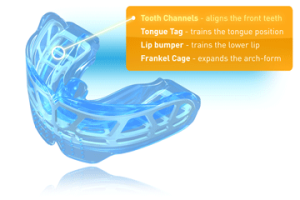
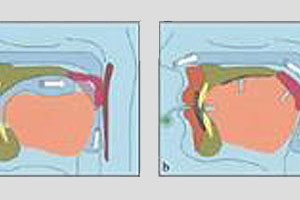 Tongue exercises recommended by Myologists can also be useful in developing a correct swallowing habit.
Tongue exercises recommended by Myologists can also be useful in developing a correct swallowing habit.